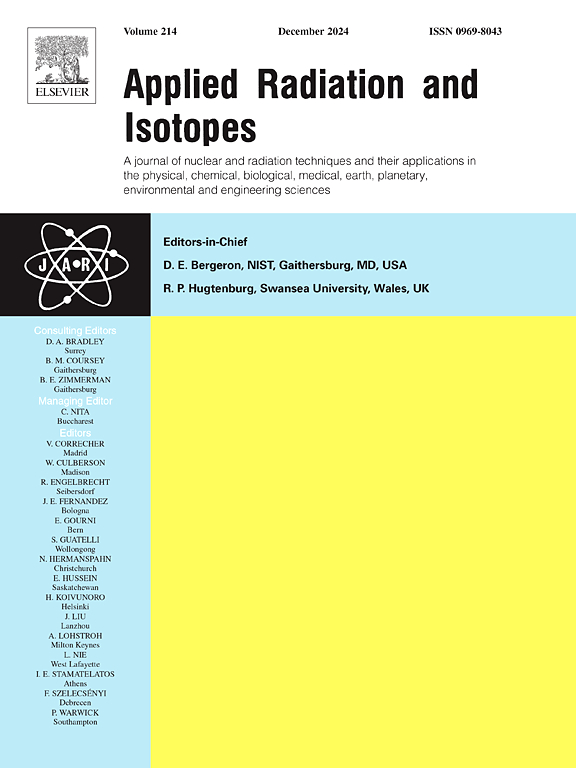Radioisotope compositional analysis using Monte Carlo γ-ray simulations and regression neural network
IF 1.6
3区 工程技术
Q3 CHEMISTRY, INORGANIC & NUCLEAR
引用次数: 0
Abstract
As a fundamental technique in radionuclide identification and radiation monitoring, spectroscopy is a common method used in risk and hazard assessment studies. Analysis in spectroscopy often involves identification and classification of radioactive sources. The knowledge of known -emitting radioisotopes allows for the distinction to be made between different species by observing certain spectral features such as photopeaks due to the specific energies of the emissions, Compton continuum due to photon scattering, X-ray fluorescence, etc. Each radioisotope is uniquely identified based on these features, allowing a model to be developed for comparing new spectral data with existing data. Various machine learning techniques have been used and tested to observe the performance of different algorithms on -ray spectra, especially in regards to species classification. More recently, deep learning methods such as deep neural networks (DNNs) have been proven to be very successful in identifying and analysing -ray spectra, often by use of a combination of simulated and experimental data. These networks can classify radioisotope energy spectra with high precision.
Being able to identify and also quantify contributions from isotopes in combination is challenging, especially where spectral features between multiple sources overlap, or the energy resolution is poor, causing further distortions in the spectrum. However, knowledge of the composition of a mixture of radiation sources is an ability which can be crucial in composition and elementary analysis from spectral information.
This work sees the development of a regression-based convolutional neural network (CNN) which attempts to predict the sources and proportions of each source in simulated mixed-source spectra. A comparison between the network and a traditional library least-squares algorithm is also made. A Monte Carlo based simulation is used to produce the spectral data, using the GEANT4 software package, for 6 different isotopes and a basic experimental design modelled after a NaI(Tl) scintillation detector. A comprehensive dataset is generated for these isotopes, for use in future analysis works. With scintillators being a common choice for field work in radiation monitoring and similar environmental studies, a network with high performance and efficiency can provide a promising tool for automated spectral analysis and detection. The model is highly efficient, being able to process batches of spectra in a second, with accurate predictions having mean-square error on the order of . It also outperforms the traditional linear method in terms of accuracy on the test data. This makes it highly portable for use in experiments and environmental radiation analysis.
用蒙特卡罗γ射线模拟和回归神经网络分析放射性同位素成分
作为放射性核素鉴定和辐射监测的一项基本技术,γ能谱是风险和危害评估研究中常用的方法。γ光谱分析通常涉及放射源的识别和分类。已知的γ发射放射性同位素的知识允许通过观察某些光谱特征来区分不同的物种,例如由于γ发射的特定能量而产生的光峰,由于光子散射而产生的康普顿连续体,x射线荧光等。基于这些特征,每种放射性同位素都被唯一地识别出来,从而可以开发一个模型,将新的光谱数据与现有数据进行比较。已经使用并测试了各种机器学习技术来观察不同算法在γ射线光谱上的性能,特别是在物种分类方面。最近,深度学习方法,如深度神经网络(dnn)已被证明在识别和分析γ射线能谱方面非常成功,通常是通过使用模拟和实验数据的结合。这些网络可以对放射性同位素能谱进行高精度分类。能够识别和量化同位素组合的贡献是具有挑战性的,特别是在多个源之间的光谱特征重叠或能量分辨率较差的情况下,这会导致光谱进一步失真。然而,了解辐射源混合物的组成是一种能力,这在光谱信息的组成和基本分析中是至关重要的。这项工作看到了基于回归的卷积神经网络(CNN)的发展,它试图预测模拟混合源光谱中每个源的来源和比例。并与传统的库最小二乘算法进行了比较。利用GEANT4软件包对6种不同的同位素进行了蒙特卡罗模拟,并根据NaI(Tl)闪烁探测器进行了基本的实验设计,得到了光谱数据。为这些同位素生成了一个全面的数据集,以供将来的分析工作使用。闪烁体是辐射监测和类似环境研究中野外工作的常用选择,一个高性能和高效率的网络可以为自动化光谱分析和检测提供一个有前途的工具。该模型非常高效,能够在一秒钟内处理一批光谱,准确的预测均方误差为~ 10−5。在测试数据的准确性方面也优于传统的线性方法。这使得它在实验和环境辐射分析中非常便携。
本文章由计算机程序翻译,如有差异,请以英文原文为准。
求助全文
约1分钟内获得全文
求助全文
来源期刊

Applied Radiation and Isotopes
工程技术-核科学技术
CiteScore
3.00
自引率
12.50%
发文量
406
审稿时长
13.5 months
期刊介绍:
Applied Radiation and Isotopes provides a high quality medium for the publication of substantial, original and scientific and technological papers on the development and peaceful application of nuclear, radiation and radionuclide techniques in chemistry, physics, biochemistry, biology, medicine, security, engineering and in the earth, planetary and environmental sciences, all including dosimetry. Nuclear techniques are defined in the broadest sense and both experimental and theoretical papers are welcome. They include the development and use of α- and β-particles, X-rays and γ-rays, neutrons and other nuclear particles and radiations from all sources, including radionuclides, synchrotron sources, cyclotrons and reactors and from the natural environment.
The journal aims to publish papers with significance to an international audience, containing substantial novelty and scientific impact. The Editors reserve the rights to reject, with or without external review, papers that do not meet these criteria.
Papers dealing with radiation processing, i.e., where radiation is used to bring about a biological, chemical or physical change in a material, should be directed to our sister journal Radiation Physics and Chemistry.
 求助内容:
求助内容: 应助结果提醒方式:
应助结果提醒方式:


